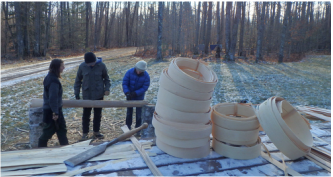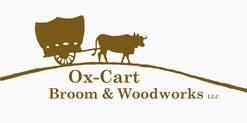|
The height of the summer season is quickly approaching - the days are growing long, there is only one small patch of snow left in a shady spot in our yard, and the spring leeks and fiddle heads are peeking through the leaves. I'm sure it will prove to be a busy one as I spend much of it with the Forest Service - paddling through the Boundary Waters Canoe Area Wilderness, maintaining campsites and portages, and conversing with other human visitors to this vast and beautiful area. I'm also looking forward to continuing to learn about traditional craft and to sell the useful items that we make. As of now, we're scheduled to be at the following festivals, and hope to add more later in the summer, so be sure to check back often!
And we're also scheduled to teach classes at a few Folk Schools throughout the season.
I hope you'll stop by one of the festivals or sign up for a class!
0 Comments
 Kerry demonstrates how to split one ring into two. Kerry demonstrates how to split one ring into two. As I’ve been immersing myself in the world of “Northern Craft” over the past year or so, I’ve had the amazing experience of learning about and participating in black ash basketry. The exact origin of this craft is unknown, but black ash baskets have played an important role in both native and Euro-American cultures of this area for hundreds of years or more. My first experience with black ash came during the winter of 2014-2015, when I started learning to weave with some material that Kerry had pounded the previous summer. I learned how to prepare the material by cutting it to width, and also that by peeling one ring into two layers, I could not only double the amount of material for weaving, but that through this process, the smooth, shiny inner surface of the black ash could be exposed for a more “polished” look. I wove a few small and simple baskets, learning about the importance of even width weavers, strong uprights, basket proportions, and wished I had a few extra arms. After moving to Minnesota and meeting numerous people who were interested in black ash basketry, but had little or no experience, Kerry and I decided to host a black ash weekend in which we could all learn about and experience the process together. It was a wonderful affair with nine people participating in some way or another. We pounded a log, removing ring by ring to produce a bathtub full of splint, wove baskets, ate delicious food, played music, relaxed in the sauna, and had general all-purpose fun.
We were out at our sugaring site on county land near out home today, when I noticed some movement from the corner of my eye. Since I haven’t spent much time in the “North Woods” for quite some time, I was startled to see a small bird with a beak almost as long as its body startle from the leaves! I had no idea what this little bird was, so I called out to Kerry who was emptying buckets a few hundred yards from where I was. I thought for sure that the bird would fly off at the sound of my voice, but it just stood there, stock still, while Kerry slowly and quietly made his way over to check it out. I quickly learned that this little bird was a Woodcock, and that they are considered a game bird in the area and usually flush when they detect a human nearby. We were able to watch this one up close for a few minutes and managed to snap a picture before made its way further into the forest.
We were thinking that perhaps this was a female that is nesting or preparing to nest and that is why she was so slow to flush, but any insight would be greatly appreciated!  Sap dripping from the spile as soon as we tapped the tree! Sap dripping from the spile as soon as we tapped the tree! Sugaring season is just about wrapping up (for maples at least – birch is next!) and I finally have a moment to sit down and reflect upon the busy season. We were planning on sugaring with a group of friends, all of whom decided fairly late in the game that they had other priorities. I’m not trying to dish out any blame or anything—just setting the stage. We had been fairly dependent on their land, firewood supply, equipment, etc., to make this season a successful one, and on top of finding out last minute that we needed to go it on our own, the trees decided to start running a few weeks earlier than normal. We were able to scramble, borrowing some taps and buckets from a friend, carving the rest of the taps out of local hazel wood, borrowing more buckets from another friend, getting free 55 gallon steel drums from a local food distributer to use for storage and sap cooking, and at the very last minute we were able to get a permit to tap on county land a few miles from our house. We were tapping literally a half hour after the permit was issued and the trees started dripping as soon as the bit got through the bark! Our goal for the year is to not have to buy any commercially produced sugar. For every gallon of maple syrup produced, we had to harvest about 40 gallons of sap, all carried or hauled on a sled about a quarter mile out from our site then brought back to the house to boil off gallons and gallons of water. It is estimated that it takes about a cord of wood to produce 10 gallons of syrup—all of which we had to cut and prep in addition to the 5 cords we needed to heat our house for the winter. As the season is winding down, we’re figuring that we’ll harvest and make about 12-13 gallons of maple syrup total. It seems like we’ve put in a lot of work, but figuring that the local market demands about $65 per gallon, we’ve made over $800 in maple syrup and should have plenty of sugar to use for the year! In addition to making syrup, it is also possible to make granulated sugar from the maple sap. We’re planning on doing that once I have a sugaring trough carved (which I started last week). I’ll post about that when the time comes!
|
Marybeth GarmoeCraftsperson Archives
August 2019
Categories |






 RSS Feed
RSS Feed

